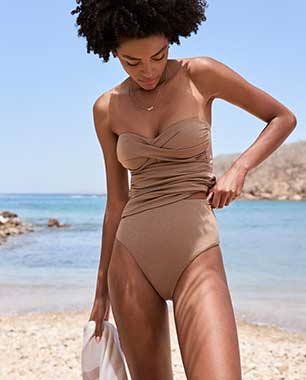Swimwear For Every Body
Shop swim essentials for women, men, and kids from our collection of bathing suits and beach accessories. Browse a variety of women's swimsuits made for all shapes and sizes. From tankinis and swim dresses, to tummy control and mastectomy suits, you'll be sure to find new swim staples for years to come.
Beach-to-boardwalk lifestyle. There was a time when going to the beach meant a canvas tote filled up with two separate outfit changes, plus swim essentials and personal items. Thankfully, times have changed. Today's tankini bathing suits or swim dresses can often double as cover-ups for easy beach-to-boardwalk. No one will be able to tell that you're wearing your favorite tankini top and swim bottoms. Similarly, if you're concerned about coverage, support, and sun protection – our collection of modest swimwear has options like shorts and rash guards that double as your t-shirt and shorts. They provide coverage, support, sun protection – and save you on packing! Recommended by The Skin Cancer Foundation as adequate protection from UV rays, our modest swimsuits not only provide full-coverage and support but are also made of UPF 50 fabric.
Carry your swim goddess status back home. The plus size swimwear that had you feeling like a total goddess while on your vacation doesn't have to hide back home. Stylish bikini tops, funky pattern bottoms, flowy swim skirts – rock anything and everything! An underwire one-piece swimsuit with a dramatic back is a sure bet, too. In Lands' End swimwear, you'll feel confident enough to shed the swimsuit cover up during vacation and comfortable enough to attend neighborhood pool parties back home.
Get All the Plus Without the Minus
Shopping for comfort and style as a plus-size woman can sometimes be challenging, but thankfully, Lands' End has you covered. We work hard crafting our size specs to make sure that our plus size line is made to flatter your body in comfort and style. When it comes to flattering plus size swimsuits, Lands' End is built for you. Choose your level of coverage and control, top to bottom - from plus size bikini tops to plus size tankinis. Looking for swim skirts and swim shorts that skim your thighs? How about tummy control swimsuits for just a little extra shaping? We've got it all, plus looks you never even knew you needed! Our women's plus size clothes are designed to give you the fit and style you want. Don't forget to check out our plus size one piece swimsuits with all-over control, specially designed with placed patterns and ruching to accent your best assets. Shop our long torso swimsuits and plus for taller figures as well.
Now Let's Talk Trends
This season, it's all about height. From women's pants to women's swimsuits and everywhere in between, high waists and high necklines are winning us over again and again. High waisted swimsuits flatter your figure by adding a bit of tummy control. High neck swimsuits (also available in high neck tankini tops) provide coverage, protection and a bit of modesty to your swim style. Not to mention they make your shoulders look amazing. You may also consider high-neck underwire tankini tops, if you're looking for a little extra support.
Swim for Him: Success in Simplicity
While refreshing your swim wardrobe, make sure to add a few men's swimsuits for him. With just a pair or two of new swim trunks and a rash guard, his summer wardrobe is refreshed and ready for adventure. Lands' End swimwear for men will stay fashionable, functionable, and fresh for years to come.
Back to Basics: Women's Apparel
Give your closet a refresh with women's clothing essentials. From a go-to 'little black dress' for cocktail parties, to cozy cardigan sweaters and flannel PJs for those chilly nights – Lands' End has got it all. You'll love our petite, plus, and tall clothing options ensured to fit and flatter every body. Be sure to try out our soft-structure wear, because elastic waistbands and stretch fabrics aren't just for workout clothes anymore. With clothes that adapt to your body and options for every season, Lands' End is your one-stop-shop for a wardrobe revamp!
Step Safely with Water Shoes
We know that water shoes are the most essential item on your list for summer. Whether you're headed to the beach, the pool, the lake, the campground, or the water park, you need to keep your feet protected and dry. We have the whole family covered with comfort and style with our large selection of quick drying water shoes for women, men, and kids. Adjustable and designed to be easy on and off in neutral colors that mix and match with any swimsuit or coverup, our water friendly men's, women's and kids' shoes are stylish enough to move with you from the sand to the boardwalk.
Summer Staples: Footwear for Sunny Days
Get ready for vacation and everyday outdoor fun with effortless fashion. Be ready for whatever the day brings with our slip-on loafers and boat shoes for men and women - they transition in a breeze from beach outings to casual gatherings. And don't forget about little ones! Our new easy on boys' and girls' sandals and sneakers in toddler, big kid and little kid sizes will keep them playing all day without a care. Whatever your warm weather adventure, we have the shoe that will fit your lifestyle.












